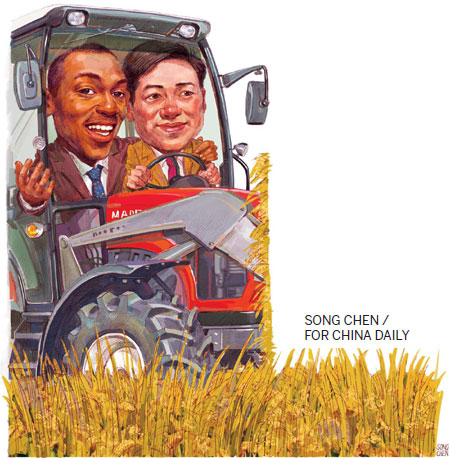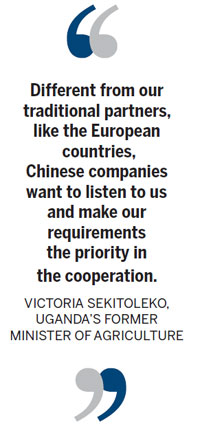

Joint efforts cultivated by China and Africa on agricultural development are bearing fruit - and many other foods
The Population Bomb, a best-selling book by Stanford University professor Paul Ehrlich published in 1968, warned of the mass starvation of humans in the 1970s and 1980s due to overpopulation. Thanks mainly to agriculturalists around the world constantly developing new agricultural techniques over the decades, Ehrlich's prediction has not been realized.
Today in Africa, the Chinese government and companies are working closely with local farmers to improve their techniques and output, and get more opportunities from unused or underdeveloped fertile land.
When the Ethiopian Prime Minister Haliemariam Desalegn visited Beijing in June, he encouraged more Chinese agricultural companies and institutions to come to Africa.
"Thanks to the continent's rich mineral and agricultural resources, the African economy has developed rapidly in recent years," he says. "China's investment in Africa's agricultural sector has great potential as the prices of food and other agricultural products keep going up." According to Desalegn, about 60 percent of the world's uncultivated arable land is in Africa, and only 17 percent the continent's arable land has been used.
"The next decade will be a critical period if Africa is to maintain the current momentum of development, and is expected to become the next emerging market and new growth pole of the world economy," he adds. "This is also a great opportunity for China."
Besides abundant natural resources, Africa also has sufficient human resources to develop local agriculture.
Nkosazana Zuma, the first woman to head the African Union Commission, says Africa is a continent of young people. By 2025, it is estimated that African youth will make up one-quarter of the world's young population. By 2040, it will be half, the majority of which will be women and girls, she says.
"This means that in the next 50 years, approximately 1.1 billion of the global workforce will be African." Zuma calls for more foreign investments in African businesses, including agriculture.
A recent report from the World Bank predicts that in three years, economic growth in sub-Saharan Africa will be more than 5 percent, and the average annual foreign direct investment in Africa will reach $54 billion.
Another report, from McKinsey Global Institute in June, predicted that Africa's agricultural output will rise to nearly $900 billion by 2030 from the current $280 billion.
Government support
In Africa, a huge population lives on productive soil but relies heavily on imported food. China's agricultural know-how is helping Africa increase its food production.
During his trip to Africa in March, President Xi Jinping announced that China is providing a $20 billion line of credit for African countries from 2013 to 2015 to strengthen cooperation in agriculture, manufacturing and other mutually beneficial areas, and help realize Africa's sustainable development.
Since the 1950s, China has sent nearly 10,000 agricultural technicians to Africa and built more than 240 agricultural projects there, the Ministry of Agriculture says.
"Opening up agriculture is an important part of China's opening-up in general," says Wang Ying, director-general of the Department of International Cooperation of the Ministry of Agriculture.
The idea of "bringing in" and "going out" is important to the ministry, and underlies Chinese agricultural exchange and cooperation programs worldwide, he says.
Agricultural trade between China and Africa has risen sharply over the past decade. It was worth $4.78 billion in 2011, almost seven times more than in 2001.
Xiao Wei, a doctoral student from the Chongqing Academy of Agricultural Sciences and a rice specialist at the Center for China Agricultural Technology in Dakawa in the Morogoro region of Tanzania, says that he believed initially that success was something that could only be created in the laboratories.
"My opinion changed after my experiences in Tanzania," he says. "I was surprised to learn that Tanzanian students were not only adept in learning the new rice-growing techniques, but equally fast in utilizing the technologies commercially.
"We were equally surprised to discover that many of the basic techniques that we use in China make a big difference in boosting yields in Africa."
The Dakawa center was a result of the Forum on China-Africa Cooperation held in Beijing in 2006, and is one of 10 such units in Africa. The 62-hectare project was set up in October 2009 by the Chongqing Sino-Tanzania Agriculture Development Co with a $6 million grant provided by the Chinese government.
|
A Uganda worker feeding fish at the fishing demonstration center set up by China in Kampala, Uganda. Photos by Zhao Yanrong / China Daily |
At the project's handover ceremony in 2011, Tanzanian President Jakaya Mrisho Kikwete said it would be a vital cog in the country's agricultural development plans.
The center mainly focuses on research and training for Tanzanian farmers, especially in Chinese agricultural techniques such as advanced seed technology.
The center has a 2-hectare experimental field, a 7-hectare exhibition field, a chicken farm and a variety of farm irrigation facilities.
It currently has 11 agricultural experts from China, specializing in growing rice, corn and vegetables, and in poultry farming. More than 300 local farmers undergo training courses at the center every year.
Chinese experts from the center have already managed to raise the average yields of hybrid rice to between 9 and 12 tons per hectare, a fourfold increase of local rice yields.
The hybrid rice seeds are expected to help Tanzanian farmers produce enough rice for domestic consumption and export, says Christopher Chiza, the Tanzanian minister for agriculture, food security and cooperatives.
Chen Hualin, a professor from the Chongqing Academy of Agricultural Sciences and head of the agricultural center, says: "We are giving Tanzanian farmers modern agricultural knowledge so they can achieve their goal of independent agricultural development."
|
Yi Ronggan, general manager of the fishing center in Uganda, says the center introduced modern technology in fishing. |
Company investment
Attracted by the fertile resources in Africa and following the Chinese government's "going out" policy, more Chinese companies are investing in African agriculture programs.
Tanzania is known as "the kingdom of Sisal" as well as a big cotton producer in the region. China State Farms Agribusiness Corp, running one of the biggest sisal farms in the country, is expected to become the largest single Tanzanian exporter by 2020. And the Dahong Group, funded by a private entrepreneur from Yancheng, Jiangsu province, is building the China-Tanzania Modern Agricultural Industrial Park, for improving local textile production.
"Different from our traditional partners, like the European countries, Chinese companies want to listen to us and make our requirements the priority in the cooperation," says Victoria Sekitoleko, Uganda's former minister of agriculture, who also served as a representative of the United Nations Food and Agriculture Organization in China, Mongolia and South Korea from 2005 to 2011.
She quotes a Chinese saying: "Give a man a fish and you feed him for a day. Teach a man to fish and you feed him for a lifetime." She believes this is the way forward for African agriculture.
In fact, fish are among the most significant of Uganda's natural resources. About 20 percent of Uganda is covered by water, providing huge potential for the country's fishing and aqua-farming industries. China is investing heavily in these areas to develop the agricultural economy.
Under the eight measures announced during the 2006 China-Africa cooperation forum by then president Hu Jintao, China has set up a $5 million fish farming demonstration center near the Ugandan capital, Kampala.
It is run by the Huaqiao Fenghuang Group from Chengdu, Sichuan province, and is the only Chinese agricultural demonstration center supported by a private company in Africa.
Among the 107 ponds at the fish farm, sit lecture rooms, laboratories, breeding units, and fish food plants.
At the center, hundreds of local farmers are trained each year in modern ways of fish farming using simple and affordable technology. Fisheries experts from across the East Africa region also visit the center to share knowledge on best practices.
"We have a lot experience in fish farming over the years," says Yi Ronggan, general manager of the fish farming center. "The skills involved in cage farming, selective breeding and feeding are all very mature in China, but in Africa, they'd never seen things like that before we arrived."
The center also introduced Chinese fish species that thrive in the African waters.
"As far as fish farming is concerned, it was made viable by this project," Justus Rutaisire, former head of the demonstration center and principal researcher, told Xinhua News Agency. "I can say this project has transformed the perception that people had about fish farming.

"People have seen fish grow from about 300 grams to about 2 kilograms in 12 months because of the ways the Chinese do fish farming. Chinese technology is going to cause a big change in this country."
Indeed, with increasing investment, Chinese private companies are set to play a more important role in African agricultural business, experts say, including demonstration centers supported by the Chinese government.
Jiang Heping is the director of the Department of Agro-Technical Economics and Scientific and Technological Development at the Institute of Agricultural Economics in Beijing and a professor at the Chinese Academy of Agricultural Sciences.
Among the 20 agricultural demonstration centers that China is setting up in African countries, Jiang helped plan eight of the programs, from selecting the sites and doing field studies to writing feasibility reports.
He says the Chinese agricultural demonstration centers are designed for three stages: first, three years for planning and construction, then three years of operation by Chinese institutions with local people, and a final three years during which African governments or companies take over with Chinese assistance.
After the nine years, local people manage and run the center themselves.
"But Chinese private companies can help them under the Chinese government's plan to continue technological influence on local development until they are fully capable of doing it. Otherwise, it would be a waste of most of the work we have done."
As the associate secretary-general of the Society of Agro-technological Economics, and the trustee of China Agricultural Economics Association, Jiang has been to Africa 15 times and visited 12 countries in the past seven years.
"I hope I can bring more information to Chinese companies that are interested in developing agricultural business in Africa, and bring more experienced Chinese farmers to the land to really build up an agricultural lifestyle in Africa through daily work," Jiang says.
zhaoyanrong@chinadaily.com.cn
|
Victoria Sekitoleko, Uganda's former minister of agriculture, agrees with the Chinese saying that "teach a man to fish, you feed him for a lifetime". zhao Yanrong / China Daily |
(China Daily Africa Weekly 06/28/2013 page1)
